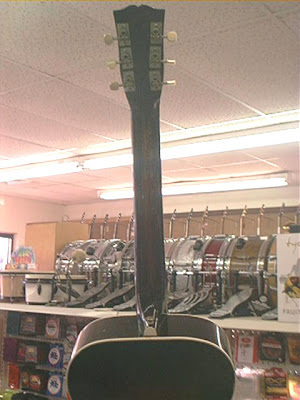c.1935 Oscar Schmidt? Unmarked "Parlor" Guitar
Update 2016: Yes, this is indeed an Oscar Schmidt. I've now worked on half a dozen of similarly-built guitars from the 30s, none with OS branding, but all clearly Schmidt makes.
This O-sized, 12-fret, pin-bridge "parlor" guitar dates to around 1935 or thereabouts. As you can see, it's got an amazing amount of awesome flame-tortoise celluloid all over it.
This O-sized, 12-fret, pin-bridge "parlor" guitar dates to around 1935 or thereabouts. As you can see, it's got an amazing amount of awesome flame-tortoise celluloid all over it.
I'm pretty sure this was made by Oscar Schmidt in New Jersey. It has the typically-OS square-cut kerfing on the inside, heavier OS-style ladder bracing, a more rugged build, and a longer 25" scale. If this were Chicago-made I'd expect a 24 1/4" scale for Regal or a 24" scale for Harmony.
Kay is another maker this could be with that longer scale (and, admittedly, Harmony used a 25" scale on many of its 14-fret models at the time), but other details pop up (the celluloid endpin type and the curious bridge pins) that also make me suspect an Oscar Schmidt make, including the slightly more belled-out body shape.
The top is solid spruce, the neck and sides appear to be stained maple, and the back is (I'm pretty sure laminate) flamed maple.
Original tuners work great and I love the celluloid veneer!
Actually, everything on the guitar is original except the 12th fret which is a replacement.
The contrasting dots are actually inlaid gold-sparkle celluloid. Weird and cool! The neck itself is a mid-size (for the time) C shape and pretty comfy. It's very different from the neck shapes I associate with most Chicago builds, as well, but that could be something of a "buyer's preference" in terms of the retail store that ordered this guitar in the first place.
My work on this instrument included a fret level/dress that removed a bit of twist/tiny bit of warp to the neck and board, a neck reset with the addition of a bolt-through mount for a bit more security, cleaning, and a bridge shave and recoloring, followed with a setup. It plays nice, now, with a set of 50w-11 strings and 3/32" action at the 12th fret.
The original fret saddle and slot were compensated to begin with so the intonation is pretty good. It's slightly sharp on the bass side after the 11th fret but right "on" on the treble. I love those celluloid-dotted bridge pins.
The "binding" is all painted-on.
It's a cool guit with a very boxy, woody tone. This makes it a great blues and ragtime guitar as it has that sort of midrange kick that's desirably for fingerpicking.
Original tuners work nice. How about that Gibson-esque "book" headstock shape? Cute!
Here you can see the bolt and brass "strap button" I've added to the heel of the guitar. The bolt goes through and secures the neck joint on the inside. Even though I reset the neck, I decided to add this as well since these dovetailed joints never were the best on production guitars of this period once you get out of the high-end realm.
The flame is actually "real" and looks nice. There are some dot water-stains on the back but otherwise it looks good. I can't tell if the stuff is veneer but I'm pretty sure it is. It's hard to see the edge of the wood because of the painted faux-binding. The back also has a bit of "waviness" to it in the middle, lower bout due to the wood settling over time, but all the braces and seams are nicely tight and good to go, so that poses no issue.
Original celluloid endpin.
UPDATE: I borrowed the below pics from an eBay auction for a late-30s Oscar Schmidt-made Sovereign archtop. Note the very similar neck shape, style, and peculiar Gibson-esque (but not quite) headstock shape. Note the same strange "flare out" at the top of the headstock "book" cutouts. I don't know of many other makers copping the open book cut in this particular style:


















Comments